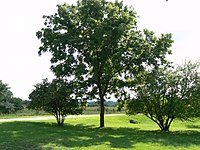Biological interaction

Biological interactions happen when different living things, like animals or plants, interact with each other in different ways. Think of it like when you play with your friends or talk to your family members; it's like that, but with different kinds of living things!
There are different kinds of biological interactions, but let's start with two of the most important ones: cooperation and competition. Cooperation happens when two or more living things work together to help each other. For example, bees pollinate flowers so that they can grow and produce their seeds, and in exchange the flowers give the bees nectar, which they turn into honey. That's a great example of cooperation!
Competition, on the other hand, happens when two or more living things compete with each other for resources like food, water, or shelter. This happens a lot in nature; for example, if two lions want to eat the same gazelle, they will have to compete to see who gets it. The stronger or faster lion will likely end up winning and getting to eat the gazelle, while the other one might have to find something else to eat.
Another kind of biological interaction is called predation. This is when one living thing (the predator) hunts and kills another living thing (the prey) to eat it. For example, a wolf hunting a rabbit or a hawk hunting a mouse.
Sometimes, living things also have a relationship called mutualism. This is when two different living things both benefit from each other's existence. For example, some birds eat bugs off of the backs of elephants, which helps the elephants avoid getting bitten by the bugs. The birds get a meal, and the elephants get some pest control!
Finally, there is also parasitism, which is when one living thing (the parasite) lives on or inside of another living thing (the host) and feeds off of it. For example, ticks and fleas feed on the blood of dogs and other animals, which can make those animals sick or uncomfortable.
Overall, biological interactions are like a big game of give-and-take between different living things. Some help each other out, some compete, and some even eat each other! But all of these interactions help keep the balance of nature, and make sure that everything continues to grow and thrive.
There are different kinds of biological interactions, but let's start with two of the most important ones: cooperation and competition. Cooperation happens when two or more living things work together to help each other. For example, bees pollinate flowers so that they can grow and produce their seeds, and in exchange the flowers give the bees nectar, which they turn into honey. That's a great example of cooperation!
Competition, on the other hand, happens when two or more living things compete with each other for resources like food, water, or shelter. This happens a lot in nature; for example, if two lions want to eat the same gazelle, they will have to compete to see who gets it. The stronger or faster lion will likely end up winning and getting to eat the gazelle, while the other one might have to find something else to eat.
Another kind of biological interaction is called predation. This is when one living thing (the predator) hunts and kills another living thing (the prey) to eat it. For example, a wolf hunting a rabbit or a hawk hunting a mouse.
Sometimes, living things also have a relationship called mutualism. This is when two different living things both benefit from each other's existence. For example, some birds eat bugs off of the backs of elephants, which helps the elephants avoid getting bitten by the bugs. The birds get a meal, and the elephants get some pest control!
Finally, there is also parasitism, which is when one living thing (the parasite) lives on or inside of another living thing (the host) and feeds off of it. For example, ticks and fleas feed on the blood of dogs and other animals, which can make those animals sick or uncomfortable.
Overall, biological interactions are like a big game of give-and-take between different living things. Some help each other out, some compete, and some even eat each other! But all of these interactions help keep the balance of nature, and make sure that everything continues to grow and thrive.
Related topics others have asked about:
